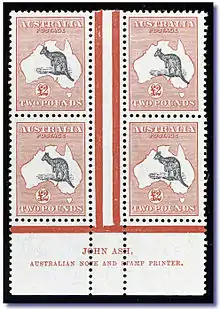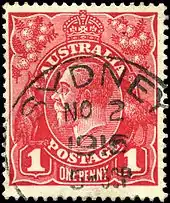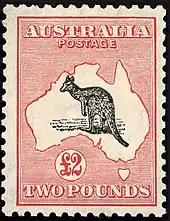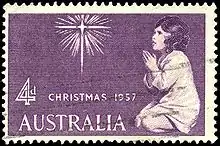

This is an overview of the postage stamps and postal history of Australia.
Postal history
The six self-governing Australian colonies that formed the Commonwealth of Australia on 1 January 1901 operated their own postal service and issued their own stamps – see articles on the systems on New South Wales (first stamps issued 1850), Victoria (1850), Tasmania (1853), Western Australia (1854), South Australia (1855) and Queensland (1860). Section 51(v) of the Australian Constitution empowered the Commonwealth to make laws in respect of “postal, telegraphic, telephonic, and other like services”.
The Commonwealth created the Postmaster-General's Department on 1 March 1901, which took over all the colonial mail systems and the then-current colony stamps. These stamps continued to be valid and became de facto Commonwealth stamps. Some of these stamps continued to be used for some time following the introduction in 1913 of the Commonwealth's uniform postage stamp series. These stamps continued to be valid for postage until 14 February 1966 when the introduction of decimal currency invalidated all stamps bearing the earlier currency.
Circumstances precluded the immediate issue of a uniform Commonwealth postage stamp. But there was no hindrance in respect to a Postage Due series. The first of these, the design of which was based on the current New South Wales postage due stamps, was issued in July 1902.
Postal rates became uniform between the new states on 1 May 1911 because of the extension of the United Kingdom domestic postal rate of 1d per half ounce (Imperial Penny Post) to Australia as a member of the British Empire. One penny became the uniform domestic postage rate. One penny postcards and lettercards also appeared in 1911. In the same year, the Postmaster-General's Department held a stamp design competition for a uniform series of Commonwealth postage stamps. This competition attracted over one thousand entries.
The "Roo" stamp


For most, Australian philately proper begins on 2 January 1913, 12 years after federation, with the issue of a red 1d (one penny) Kangaroo and Map, the design of which was adopted in part from the entry that won the Stamp Design Competition.[1] This was the first definitive stamp with the sole nomenclature “Australia”. Although the delay between federation and the first stamps had several causes, one of the major reasons was political wrangling regarding the design. There was a considerable amount of opposition to any inclusion of British royal symbols or profiles.[2]
A design completion was announced in 1911, and several designs, including royal profiles were chosen. The government decided on having only one design, and Charlie Frazer, then postmaster-general, inspired the basic outline of the new design.[3] Blamire Young, a local watercolour artist, was commissioned to produce the final design.
The first definitive issue had fifteen stamps ranging in value from ½d (halfpenny) to £2 (two pounds).[2] The Kangaroo and Map design was ordered by the Fisher Labor Government, which had in its ranks a number of pro-republicans who strenuously opposed the incorporation of the monarch's profile on Australian stamps. One of the first acts of the Cook Liberal Government, sworn in on 14 June 1913, was to order a series of postage stamps with the profile of George V. On 8 December 1913 the first of these, an engraved 1d carmine-red, appeared. Soon after, typographed values of the design ranging from ½d (halfpenny) to 1/4d (one shilling and four pence) appeared. The Postmaster-General's Department then went on to keep both basic designs on issue – 38 years for the Kangaroo and Map design, and 23 years for the George V (upon his death).
In 1948,[4] H. Dormer Legge published the first definitive study of these stamps, The Kangaroo Issues of the stamps of the Commonwealth of Australia.
Later definitive stamps
With the accession of George VI in 1936 until the early 1970s, Australian definitives featured the monarch, Australian fauna and Australian flora. However, particularly in the late 1950s, the depiction of the monarch – now Elizabeth II – on Australian definitives became confined to the base domestic letter rate and the preceding minor values. With the introduction of decimal currency on 14 February 1966, 24 new definitives were issued – the monarch was featured on the minor values (1c to 3c) and on the base domestic letter rate (4c) and the remainder featured Australian birds, Australian marine life, and early Australian maritime explorers. A feature of this issue was that where there was a direct conversion of value, the design was changed to reflect the new decimal currency value – for example, the 2/6d (two shilling and sixpence) Scarlet Robin definitive (issued 21 April 1965) become the new 25c decimal currency value; likewise the £2 (two pounds) Phillip Parker King definitive (issued 26 August 1964) became the new $4 decimal currency value.
The last base domestic letter rate definitive stamp featuring the monarch appeared on 1 October 1971. Since then, the designs of all Australian definitive values have focused on fauna, flora, reptiles, butterflies, marine life, gemstones, paintings, handicrafts, visual arts, community and the like. From 1980, a stamp has been issued annually to commemorate the monarch's birthday.
First commemorative stamp
Australia's first commemorative stamp was issued on 9 May 1927 to mark the opening of the first Parliament House in Canberra. Subsequently, issues have appeared regularly commemorating Australian achievements and landmarks in Australian history. The first Australian multicoloured stamps appeared on 31 October 1956 as part of the Melbourne Olympic Games commemorative issue. These were printed by a foreign company. The first Australian-printed multicoloured stamp, commemorating the 50th anniversary of the Australian Inland Mission, was issued on 5 September 1962.

There have been many special issues. The first Christmas stamp appeared on 6 November 1957. In recent years, designs for the Christmas issue have alternated each year between the religious and the secular. From 1993, in October of every year, Australia Post has commemorated Stamp Collecting month with special issues, typically featuring topics that are of interest to children such as pets, native fauna and space. Commencing with the 2000 Sydney Olympic Games, during the Summer and Winter Olympic Games, stamps featuring Australians who have won an Olympic gold medal are issued on the next postal business day after the achievement.
Airmails
Australia's first airmail-designated stamp appeared on 20 May 1929. A special 3d (three pence) airmail stamp was available for mail sent on the Perth-Adelaide air service. The cost of this service was 3d per ½ oz plus normal postage. On 19 March 1931 and 4 November 1931, a further two airmail-designated stamps, both 6d (sixpence), appeared. After these, general definitives were used for mail sent by air.
Stamp booklets
Coin-operated vending machines were introduced in 1960 and have continued in various forms to the present day. These included Frama vending machines stamps, first issued in 1984 and discontinued in 2003, as well as various booklets. Booklet stamps were discontinued in 1973 but were reintroduced some years later. Stamp booklets were available from Advance Bank ATMs from 1984 until the bank's merger with St George Bank in 1996. These were Australia's first (and, to date, only) triangular stamp issue.
Self-adhesive stamps
Self-adhesive stamps were first issued in 1990. The first self-adhesive commemoratives appeared in 1993. Self-adhesive stamps have proved popular with users and very soon came to be in more common use than gummed stamps. Australia issues gummed versions of all self-adhesive stamps.
Prior to 1997, the only living persons to appear on stamps were the reigning monarch and other members of the royal family. Since 1997, Australia Post[5] has issued stamps commemorating living Australians. In particular, an annual Australian Legends issue has commemorated living Australians who have made some significant contribution during their lives.
Stamps with personalized tabs were introduced in 1999. Australia Post has also used tabs to commemorate themes and individuals not considered significant enough for a stamp issue of their own.
Postal rates
Since the introduction of the Goods and Services Tax, separate stamps were introduced for domestic and international postage in 2001. Stamps inscribed "International Post" are not valid for domestic postage. Domestic stamps can be used for overseas postage but contribute less than face value towards the postage (the user must deduct the tax component).
Official Service stamps
From the 1913 to 1930, Commonwealth and State Government agencies used stamps (perfins) punctured with OS (“Official Service”). In 1931 the puncturing system was abandoned and stamps for government mail were overprinted OS. In February 1933, it was decided that government mail would no longer require postage stamps. The exception to OS stamps being restricted for the use of government agencies was the 4 November 1931 6d airmail stamp. The OS overprinted stamp was sold over post office counters to prevent speculation and was valid for all types of mail.
Joint issues
Australia has had joint stamp issues with New Zealand (1958, 1963 and 1988), the United Kingdom (1963, 1988 and 2005), some of its external territories (1965), the United States of America (1988), the U.S.S.R. (1990), People's Republic of China (1995), Germany (1996), Indonesia (1996), Singapore (1998), Greece (2000), Hong Kong (2001), Sweden (2001), France (2002) and Thailand (2002).
Postal stationery
Postal stationery was first issued by the Commonwealth of Australia in April 1911.[6] Postcards based on the design of South Australia 1893 postcards and a "Stamp" design of a full face of King George V, engraved by Samuel Reading, were issued in April 1911.[6] Letter Cards with the same "Stamp" design were also issued. Envelopes, Registered envelopes and Newspaper wrappers were first issued in 1913, using the "Kangaroo on Map" "Stamp" design by Blamire Young.[6] Aerogrammes were first issued in 1944.
External territories
Each Australian external territory has a specific postal and philatelic history.
Formerly administered by New South Wales, Norfolk Island used that colony's stamps after 1877. Norfolk Island used stamps of Australia between 1913 and 1947, attained postal independence and issued its own stamps on 10 June 1947.[7] Norfolk Island lost postal independence in 2016.[8]
The Territory of Papua, officially a British colony but administered by Australia, issued its own stamps from 1901. before this, it had used Queensland stamps. Stamps of Australia were issued there between 1945 and 1953 in the new Territory of Papua and New Guinea.[9][10]
Transferred from Singapore to Australia by the United Kingdom in the 1950s, Christmas Island and Cocos (Keeling) Islands were progressively and separately integrated[11] into the Australian postal system and losing their postal and philatelic independence in the 1990s. While Christmas Island had postal independence and issued its own stamps since 1958, the Cocos Islands used stamps of Australia from 1952 until its postal independence in 1979. The first Cocos stamps were issued in 1963.
Both territories lost their postal independence to Australia Post in 1993 for Christmas Island and 1994 for the Cocos Islands. Consequently, their stamps became valid within Australia and stamps of Australia became valid in the islands.[12][13]
The Australian Antarctic Territory had always been using stamps of Australia but disposed of its stamps since 27 March 1957. They are valid for postage within Australia.[14]
Military occupations and mandates

With military operations during World War I, Australia occupied two former German colonies, German New Guinea and Nauru. German colonial stamps were overprinted, followed by Australian stamps overprinted "North West Pacific Islands" in 1915. In the 1920s, stamps were issued for these two territories as League of Nations mandates.
Nauru and New Guinea were under Japanese occupation in 1942. At the end of World War II, in 1945, stamps of Australia were used in mandate of New Guinea and in Papua until 1 March 1953. The new combined Territory of Papua and New Guinea received its own stamps bearing the name "Territory of Papua and New Guinea" until its independence in 1975.[15][16]
British Commonwealth Occupation Force

Between October 1946 and February 1949, in occupied Japan, the Australian stamps used as such by the military post offices were overprinted "B.C.O.F. / JAPAN / 1946" to avoid speculation on the currency value.[17]
See also
- Kangaroo stamps of Australia
- Postage stamps and postal history of the Australian Antarctic Territory
- Postage stamps and postal history of New South Wales
- Postage stamps and postal history of Queensland
- Postage stamps and postal history of South Australia
- South Australian stamp overprints
- Postage stamps and postal history of Tasmania
- Postage stamps and postal history of Victoria
- Postage stamps and postal history of Western Australia
- Revenue stamps of Australia
- Postage stamps and postal history of New Zealand
- List of postage rates in Australia
References and sources
- Notes
- ↑ "The Kangaroo and Map Stamp Design". Retrieved 26 December 2017.
- 1 2 The Australian Stamp Catalogue, 1976 edition
- ↑ McMullin, Ross. Australian Dictionary of Biography. National Centre of Biography, Australian National University. Retrieved 26 December 2017 – via Australian Dictionary of Biography.
- ↑ The receipt of the book is noted in the London Philatelist, Vol. 57, No. 673, December 1948, p. 222.
- ↑ See auspost.com.au. Archived 2008-05-04 at the Wayback Machine
- 1 2 3 Darke, B C, The Postal Stationery of the Commonwealth of Australia, 1976
- ↑ "Norfolk Island", Commonwealth Stamp Catalogue. Australia, Stanley Gibbons, 4th edition, 2007, ISBN 978-0-85259-666-1, page 120.
- ↑ See Postage stamps and postal history of Norfolk Island for more details.
- ↑ "Papua (British New Guinea)" (pages 135 et 138) and "Papua New Guinea" (page 138), Commonwealth Stamp Catalogue. Australia, Stanley Gibbons, 4th edition, 2007, ISBN 978-0-85259-666-1.
- ↑ See Postage stamps and postal history of Papua New Guinea for more details.
- ↑ Due to their divergent local histories. Christmas Island was then locally administered by a phosphate company and Cocos Islands were the property of a civil family and watched by British and Australian forces because of the islands' role in intercontinental telecommunications.
- ↑ "Christmas Island" (pages 104 and 109) and "Cocos (Keeling) Islands" (pages 112 and 115), Commonwealth Stamp Catalogue. Australia, Stanley Gibbons, 4th edition, 2007, ISBN 978-0-85259-666-1.
- ↑ See Postage stamps and postal history of Christmas Island and Postage stamps and postal history of the Cocos (Keeling) Islands for more details.
- ↑ See Postage stamps and postal history of the Australian Antarctic Territory for more details.
- ↑ "Nauru" (pages 117–118), "New Guinea" (pages 118–119) and "Papua New Guinea" (page 138), Commonwealth Stamp Catalogue. Australia, Stanley Gibbons, 4th edition, 2007, ISBN 978-0-85259-666-1.
- ↑ See Postage stamps and postal history of Nauru and Postage stamps and postal history of Papua New Guinea for more details.
- ↑ "British Commonwealth Occupation Force (Japan)", Commonwealth Stamp Catalogue. Australia, Stanley Gibbons, 4th edition, 2007, ISBN 978-0-85259-666-1, page 102.
- Sources
- Australia Post Philatelic Group: Australian Stamp Bulletin. Melbourne: Australian Postal Corporation, various bulletins.
- Higgs, John: The Australasian Stamp Catalogue. Sydney: Seven Seas Stamps, 1996.
- Kellow, Geoffrey, and others: Australian Commonwealth Specialist’ Catalogue. Sydney: Brunsden-White, 1988–2002.
- Pitt, Alan: Stamps of Australia. Sydney: Renniks Publications, 2005.
Further reading
- Dormer Legge, H. (1948) The Kangaroo Issues of the stamps of the Commonwealth of Australia. Melbourne: Orlo Smith & Co.
- Dormer Legge, H. (1979) The 1913 Penny Kangaroo of Australia. London: Stanley Gibbons.
- Kellow, G N (1985). Kangaroos The Last Victorian Issue. Richard C Peck. ISBN 0-949177-03-2.
- Rosenblum, Alec A. The Stamps of the Commonwealth of Australia: a handbook for philatelists. Melbourne: Acacia Press, 1968 636p.